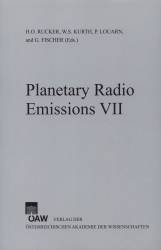
Planetary Radio Emissions VII, pp. 129-132, 2011/12/28
Proceedings of the 7th International Workshop on Planetary, Solar and Heliospheric Radio Emissions held at Graz, Austria, September 15–17, 2010

Electron density measurements from the Cassini RPWS Langmuir Probe instrument have identified a sharply-defined region of low plasma densities in Saturn’s magnetosphere outside a dipole L-shell of ~15. Gradients in the density profiles define a boundary identified as the plasmapause [Gurnett et al., 2010] that separates the region of higher plasma density from the region of very low plasma density. During seven consecutive high-latitude passes in the northern hemisphere from September through December 2006, Cassini followed a series of trajectories that skimmed along high-latitude magnetic field lines for several days. The orientation of these trajectories made it possible for the RPWS to detect modulations in the high-latitude auroral hiss emissions at a 10.6 hour rotational modulation rate [Gurnett et al., 2009] and for the RPWS Langmuir Probe instrument to detect modulations in the electron density profiles that were anti-correlated with the hiss emissions [Gurnett et al., 2010]. The strong and periodic modulations in the density profiles indicate that Cassini is passing in and out of a plasma region of higher densities. One example during this seven-orbit time interval is shown in Figure 1. The periodic modulations in the density profile are shown in the bottom panel and are clearly anti-correlated with the periodic occurrence of intense auroral hiss emissions shown in the upper panel. The highest densities in this high-latitude region are 0.1 cm-3, two orders of magnitude greater than the lowest densities in this part of Saturn’s magnetosphere but well below the densities seen inside Saturn’s plasma disk [Morooka et al., 2009;Persoon et al., 2009].